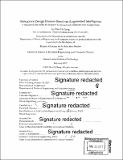| dc.contributor.advisor | Takehiko Nagakura and Patrick H. Winston. | en_US |
| dc.contributor.author | Cheng, Chin-Yi | en_US |
| dc.contributor.other | Massachusetts Institute of Technology. Department of Electrical Engineering and Computer Science. | en_US |
| dc.date.accessioned | 2017-05-11T20:00:50Z | |
| dc.date.available | 2017-05-11T20:00:50Z | |
| dc.date.copyright | 2017 | en_US |
| dc.date.issued | 2017 | en_US |
| dc.identifier.uri | http://hdl.handle.net/1721.1/109017 | |
| dc.description | Thesis: S.M., Massachusetts Institute of Technology, Department of Architecture, 2017. | en_US |
| dc.description | Thesis: S.M., Massachusetts Institute of Technology, Department of Electrical Engineering and Computer Science, 2017. | en_US |
| dc.description | Cataloged from PDF version of thesis. | en_US |
| dc.description | Includes bibliographical references (pages 101-102). | en_US |
| dc.description.abstract | Designers can use artificial intelligence, such as Genetic Algorithms, to deal with the design problems which seem impossible to be quickly resolved by the human mind. However, none of the current Al algorithms interact with the designers while executing the assigned tasks. Therefore, when the designers use Al to generate design solutions, they can only pick from the results and often feel that their creativity is deprived. Also, it is often the case that designers are not satisfied with the generated results because the algorithms cannot optimize goals which have not been represented as numerical values, such as aesthetic. Moreover, even if designers wanted to use Al algorithms for their design problems, most of them do not have enough programming skills to implement the algorithms, let alone use Al to solve design problems. Therefore, in this thesis, I propose a framework and a toolkit for designers to interact and collaborate with Al algorithms. Following this framework, designers with moderate programming ability should be able to embed Al algorithms in the toolkit into their design process and make the design process interactive. With the interactive assistance from the Al algorithms, designers not only have full control of the results, but can also tackle difficult problems and iterate the design outcomes smoothly, as if their intellect is augmented. To prove the feasibility of this idea, I demonstrate several examples of how to follow the framework and how to use each Al algorithm in the toolkit. I also create an interactive design tool for a modular kinetic structure system. The tool for the structure system utilizes multiple Al algorithms to show that the framework and toolkit can help designers navigate a complex design problem. Finally, I will open the toolkit and examples to the computational design and computer science community. | en_US |
| dc.description.statementofresponsibility | by Chin-Yi Cheng. | en_US |
| dc.format.extent | 107 pages | en_US |
| dc.language.iso | eng | en_US |
| dc.publisher | Massachusetts Institute of Technology | en_US |
| dc.rights | MIT theses are protected by copyright. They may be viewed, downloaded, or printed from this source but further reproduction or distribution in any format is prohibited without written permission. | en_US |
| dc.rights.uri | http://dspace.mit.edu/handle/1721.1/7582 | en_US |
| dc.subject | Architecture. | en_US |
| dc.subject | Electrical Engineering and Computer Science. | en_US |
| dc.title | Interactive design process based on augmented intelligence : a framework and toolkit for designers to interact and collaborate with AI algorithms | en_US |
| dc.title.alternative | Framework and toolkit for designers to interact and collaborate with AI algorithms | en_US |
| dc.type | Thesis | en_US |
| dc.description.degree | S.M. | en_US |
| dc.contributor.department | Massachusetts Institute of Technology. Department of Architecture | |
| dc.contributor.department | Massachusetts Institute of Technology. Department of Electrical Engineering and Computer Science | |
| dc.identifier.oclc | 986529599 | en_US |
